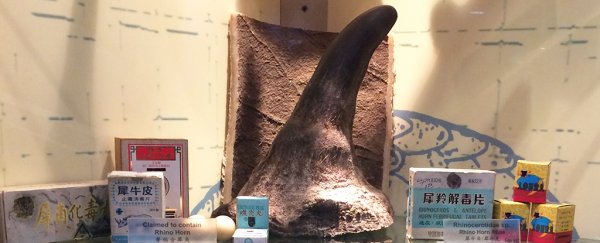DNA is helping solve a new type of crime scene - linking the DNA of rhino horns confiscated from poachers and traffickers to specific sites where carcasses of the murdered rhinoceroses are found.
To date, the Rhino DNA Index System (RhODIS) has been used to match rhino DNA to over 120 criminal cases.
"Unlike similar work in which genetic databases provide an indication of geographic provenance, RhODIS provides individual matches that, similar to human DNA profiling, is used as direct evidence in criminal court cases," said researcher Cindy Harper of the University of Pretoria in South Africa.
In Africa, thanks to conservation efforts, populations of white and black rhinoceroses have been slowly gaining. The near-threatened white rhino has increased from estimated numbers as low as 50-100 individuals in the early 20th century to around 20,000 animals today, and the critically endangered black rhino is at somewhere between 5,042 and 5,458, up from 2,410 in 1995.
But poaching has also increased dramatically since 2007. In 2016, 1,054 rhinos were reported killed in South Africa. That's around 6 percent - perilously close to the birth rate, which means even a slight increase in killings would see an immediate decline in population figures.
Although there is absolutely no medical benefit to rhino horn whatsoever, it's still considered an effective treatment for cancer, and demand has been soaring, particularly in the burgeoning market of Vietnam.
The database, which was started in 2010, comprises 20,000 samples - from living rhinos, from confiscated rhino horns, from carcasses, from bloodstains and from curios or powdered horn.
And the research team has now demonstrated that it can be reliably used to match forensic evidence to specific animals.
To determine the probability of a match, they analysed genetic material from 3,085 white rhinos and 883 black rhinos. They looked at how frequently gene variants appeared at specific points on the chromosome. This is called allele frequency, and it can be used to show genetic diversity within a species.
The higher the genetic diversity, the better the chances of an accurate DNA match.
The team's findings show that it's possible to reliably match the DNA of a specific rhino to any tissue, including bloodstains and powdered horn.
Their report details nine cases that have been concluded in court using successful DNA matches from the RhODIS database. Most were matching horns with a carcass, but one matched a genetic profile retrieved from the poacher's clothing to a white rhino carcass, and another matched bloodstains found on a poacher's carpet to a black rhino.
All were sentenced to jail, with the shortest sentence being 8 years.
The team is now working on increasing the database and analyse more of the samples already contained therein.
"This effort will further ensure that the survivors remain healthy while efforts to curb wildlife trafficking and educate consumers continue," Harper said.
The research has been published in the journal Current Biology.
